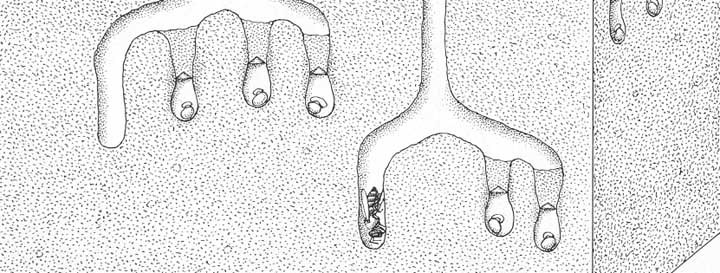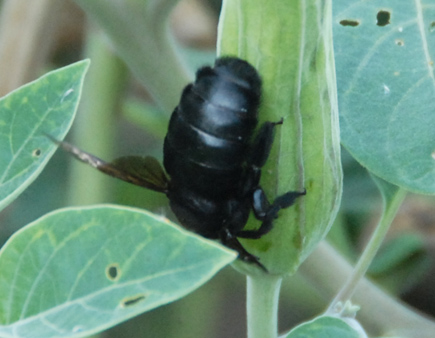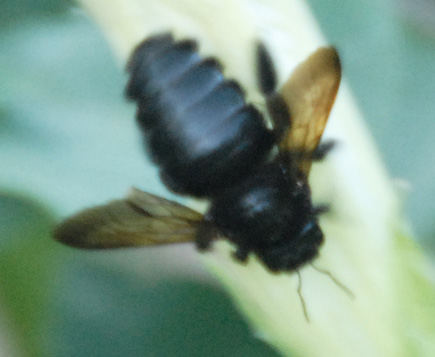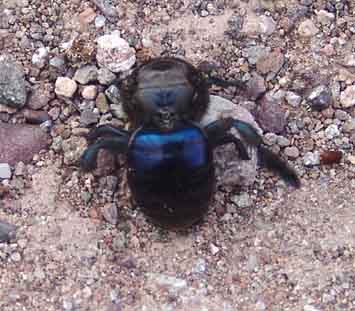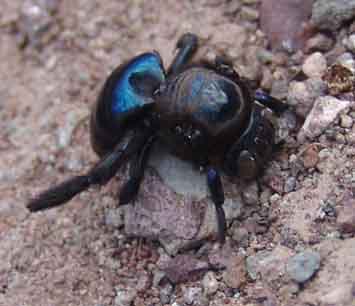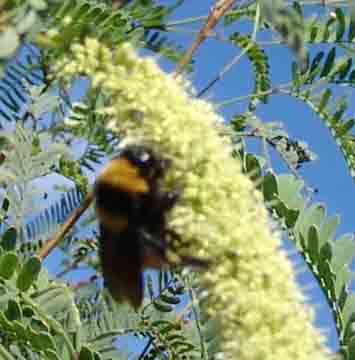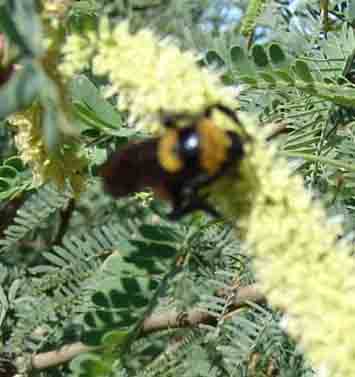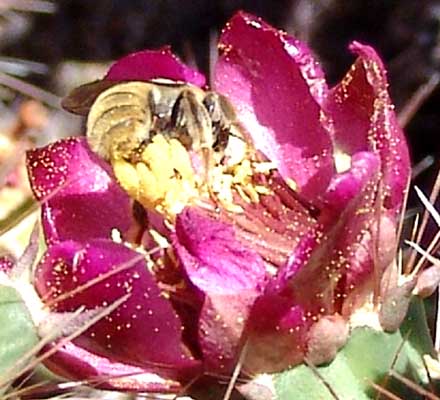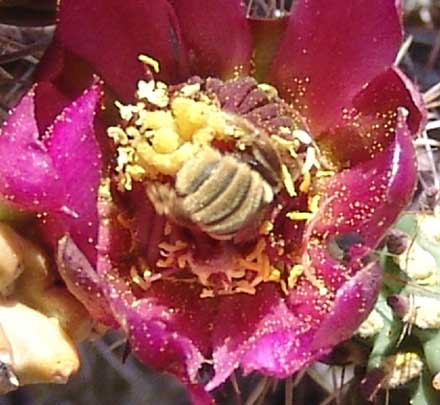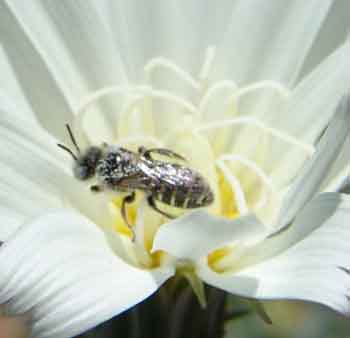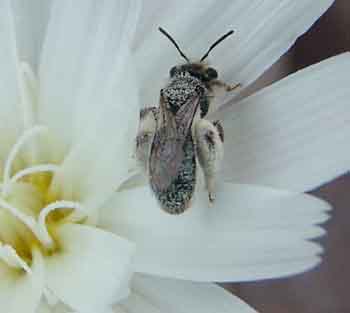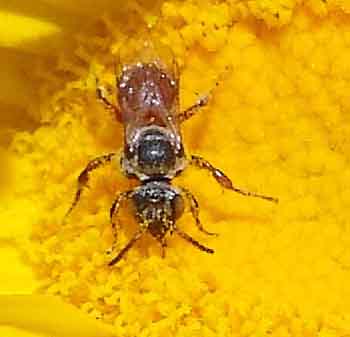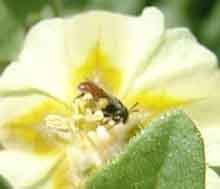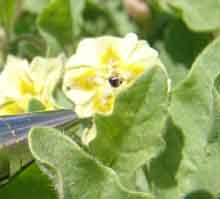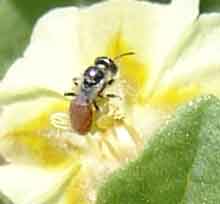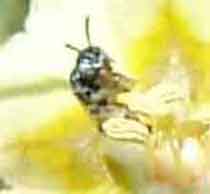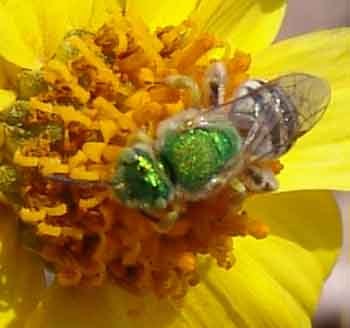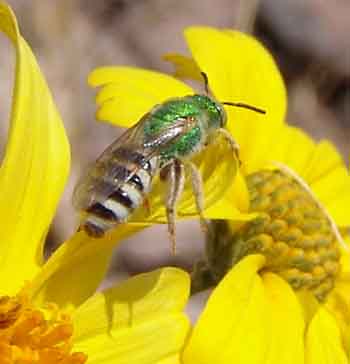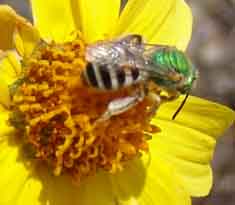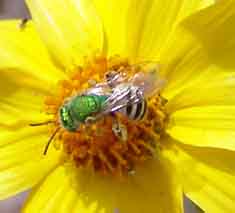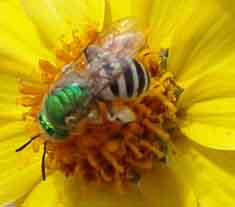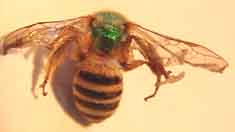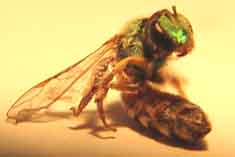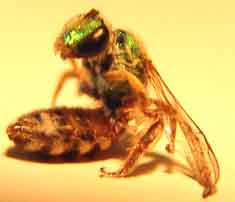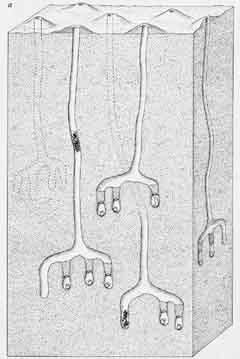Solitary Bees
Main sources: O'Toole, Christopher & Anthony Raw, 1991, Bees of the World, London: Blandford; Batra, Suzanne, 1984, "Solitary Bees", Scientific American 250:2:120-27; "Cactus Bees",The Bee Works (thanks to Dr. Stephen Buchmann); Buchmann, Stephen & Gary Nabhan, 1996, The Forgotten Pollinators, Washington DC: Shearwater Books; Chambers, Nina et al, 2004, Pollinators of the Sonoran Desert: A Field Guide, produced in partnership by the Arizona-Sonora Desert Museum, International Sonoran Desert Alliance, and The Bee Works.
While most of us think of swarms, hives, queens, workers, honeycombs, and stings when we speak of bees, and believe people have to bring in professional hive keepers to ensure that local crops get pollinated, more than 85% of the some 20,000 species of bees in the world don't fit this image -- they are "solitary", meaning they have no socially structured specialization of workers and queens, rather each female bee builds her own nest, provides nectar and pollen in each cell for her larvae to eat lays eggs in its cells, and then seals the nest and departs. Typically this mother will die before her offspring emerge.
Solitary bees are highly diverse, found in nine distinct families -- including membrane bees, digger bees, sweat bees, leafcutter bees, mason bees, alkali bees, carpenter bees, miner bees, orchid bees, bumblebees, and others. Most solitary bees make their nests underground, preferring sites where soil is exposed to morning sun, and in desirable locations they may form large "villages" of nests.
See Cactus Bees for one very important group of Solitary Bees found in our area.
Carpenter Bees (Family Anthophoridae)
Below, two views of a Carpenter Bee as it plied its way among the now-closed Datura blossoms of late summer. (Click on each image to enlarge it.)
We encountered this Carpenter Bee near the Big Tank in October 2005. It was dead, but had died just recently. We collected the specimen, planning to photograph it more carefully, but then somehow lost it so unfortunately these two images are the best we have at this point: (Click on each image to enlarge it)
This corpse has lost some of its body parts, but it is probably a Xylocopa species, most of which are tropical to subtropical in distribution. The female uses both sound and rotten wood to excavate a tunnel, running the main part along the grain of the wood. In desert areas some species line the tunnel with a waterproof secretion from their abdominal glands, which prevents dessication, and after the tunnel is finished they bring pollen into the cell before laying a large egg onto the mass.
Below -- unfortunately, poorly focused -- a Bumblebee feasts on a Velvet Mesquite flower near the Diversion Tank on August 21, 2004 (Click on each image to enlarge it):
Below, another kind of Solitary Bee wallows in the flower of an Engelmann Prickly Pear on May 10 2004. These bees often disappear into the depths of these flowers, their presence signalled momentarily only by the waves generated in the sea of stamens as they swim through the pollen:
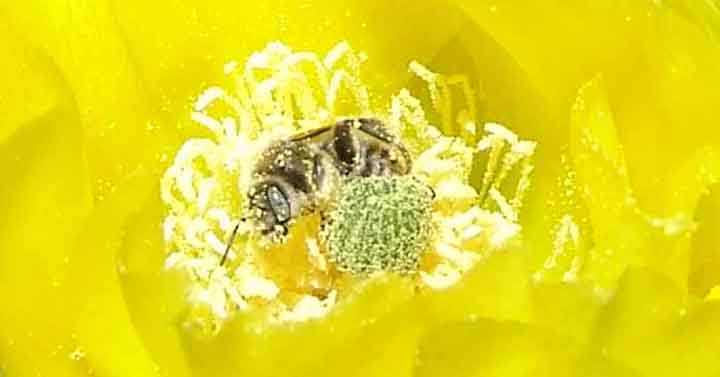
This may be the same kind, photographed deep into Staghorn Cholla blossoms in May 2007:
We found these two bees, below, feasting on Chicory flowers in March 2005. (They appear to be of different species.) Note how the scopa (pollen-collecting leg hairs, in this example) of the one on the right are heavily laden with pollen: (Click on each image to enlarge it):
Below, a mystery bee, photographed on a Desert Marigold in April 2005: (Click on the image to enlarge it):
We saw a very similar bee feeding in a Velvet Five-eyes flower in September 2006 near the Red Tank, as shown in these images below:
For scale, the diameter of the barrel-tip of the pen in the image second from the left above is about 3 mm.
..................................................................
European Honeybees, among the most social of bees, may be regarded (says Gary Nabhan, in Buchmann & Nabhan, 1996, cited above) as harmful invasive species -- honeybees adversely effect invertebrate pollinizers in Australia; where they displace native solitary bees but do not pollinate certain kinds of plants. Influence of honeybees on plant communities may be greater than cattle in the United States: "Honeybees are... herbivores with wings -- that are just as capable of taming a landscape as any cow, sheep, or goat infestation." (p. 183)
Sweat Bees (Family Halictidae)
Members of this Family are dark-colored, often metallic green or black, of a range of sizes. They are valuable plant pollinators. We photographed these in late February 2006, working on some Brittlebush blossoms -- the only flowers in sight. We provide a series of images here to show the eyes, the pollen-filled scopa etc. (Click on each image to enlarge it)
We found this one below dead in a Rain Gauge in Hot Springs Canyon in October 2005. This one is quite small -- the length of its abdomen is roughly 6 mm.
Most sweat bees nest in burrows in the ground, sometimes quite solitary, but often many of them nest close together, sometimes even sharing common passageways from their burrow to the outside. A few may be considered "primitive eusocials".
The image to the left (Click on the image to enlarge it) illustrates the nest-building process of an alkali bee (Nomia melanderi) [from Batra 1984:124]. Many other types of nest (including some drilled into wood, etc.) are constructed by other kinds of solitary bees.
